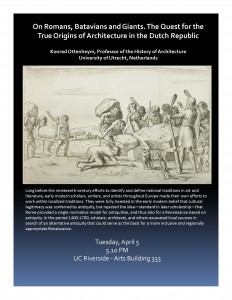Konrad Ottenheym, University of Utrecht, Netherlands
 On Romans, Batavians and Giants. The Quest for the True Origins of Architecture in the Dutch Republic
On Romans, Batavians and Giants. The Quest for the True Origins of Architecture in the Dutch Republic
Konrad Ottenheym, Professor of the History of Architecture
University of Utrecht, Netherlands
In thinking about the creation of ‘national literature’ and ‘national styles’ in art and architecture, most people will refer to the 19th century: the period of the rise of national states and the attempt to codify specific geographically and nationally defined identities in art, architecture and literature, based on models from a glorious past. Nevertheless, five hundred years before this era, humanist scholars, artists, monarchs and other political leaders all over Europe had already charged themselves with a comparable task. In late medieval and early modern Europe, c. 1400–1700,
authority was formally based on lineage, and in all countries political ambitions and geographical claims were supported by true or false historical justifications. Literature, architecture, and paintings were also used to express these ideas of national or local history and that its earliest roots in the distant past.
The strong and conscious interest in national and local history as expressed during this period in the arts has not yet been studied systematically in an interdisciplinary way. In art history, most
attention is still given to the reception of the ‘international’ canon of Greek and Roman antiquities – such as the well-known ruins in Rome and its surroundings – and of ‘classical’ Greek sculpture. And until rather recently, research on Neo-Latin literature was focused on the reception of the classical Greek and Roman authors, while historical works on the ‘medieval’ or local past were neglected. The local or medieval past, however, played a pivotal role. In current mainstream interpretations of ‘Renaissance’ art as a ‘Rebirth of Antiquity,’ antiquity has misleadingly acquired a standard definition based on the international canon. In this perspective, there seems to be only one ideal Antiquity and only one proper embodiment of Antiquity Reborn: the reception of Rome’s antiquities in 15th- and 16th-century Florence and Rome. Thus, the bias toward a ‘proper’ antiquity has generated the idea of a ‘proper’ Renaissance. Consequently, most Antiquity-inspired architecture, art, and literature in Northern Europe – as well as in Spain, France, and the Italian periphery from Lombardy to Sicily – has been analysed and interpreted with Central Italian solutions as a single point of reference, and has often been seen as ‘provincial,’ ‘hybrid,’ or ‘still a little bit medieval.’ As a result, the specific meaning of conscious references to local history also remained obscure. Instead of addressing incorrect or vernacular transformations of the Roman ideal, however, we have to look for a more positive explanation for those examples of the Antique that do not resemble the ‘standard.’ Therefore, we must ask by what means – i.e., through which other models or interpretations of antiquities – artists and patrons created their reconstructions of Antiquity.
In the past few decades the concept of the Rome-centered Renaissance has been seriously challenged. Recent scholarship has stressed the important role assumed by non-Central Italian
antiquities – such as those of Ancient Gaul and in the Low Countries, as well as texts such as Tacitus’s Germania – in the genesis of ‘Antique’ architecture that was not inspired by Central Italy. Moreover, the definition of the ‘Antique’ has turned out to be far more elastic: in fact, it encompasses more than ‘Rome.’ The historical eras used in such constructions could be rather diverse. Sometimes passages or episodes from classical historical writings were quoted and integrated into early modern national or local history, such as the tales of the Trojans who had left their destroyed city to become the founders of various peoples, cities, or noble families all over Europe. In the construction of national histories, local tribes mentioned in classical texts sometimes played a central role as true and antique ancestors, like the Batavians in the northern Low Countries or even elder ancestors, as will be explained in this lecture.
